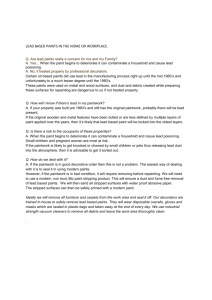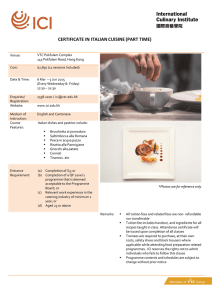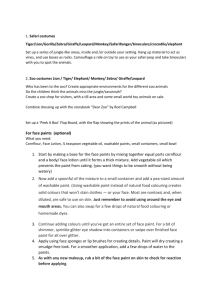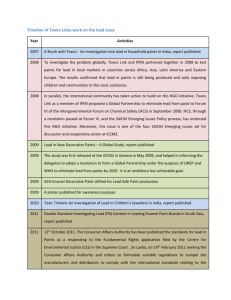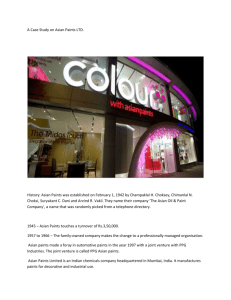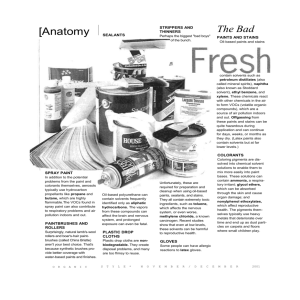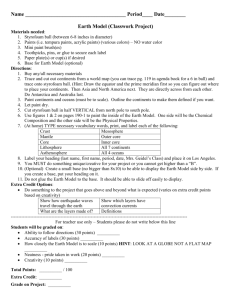Introduction - Duke University`s Fuqua School of Business
advertisement
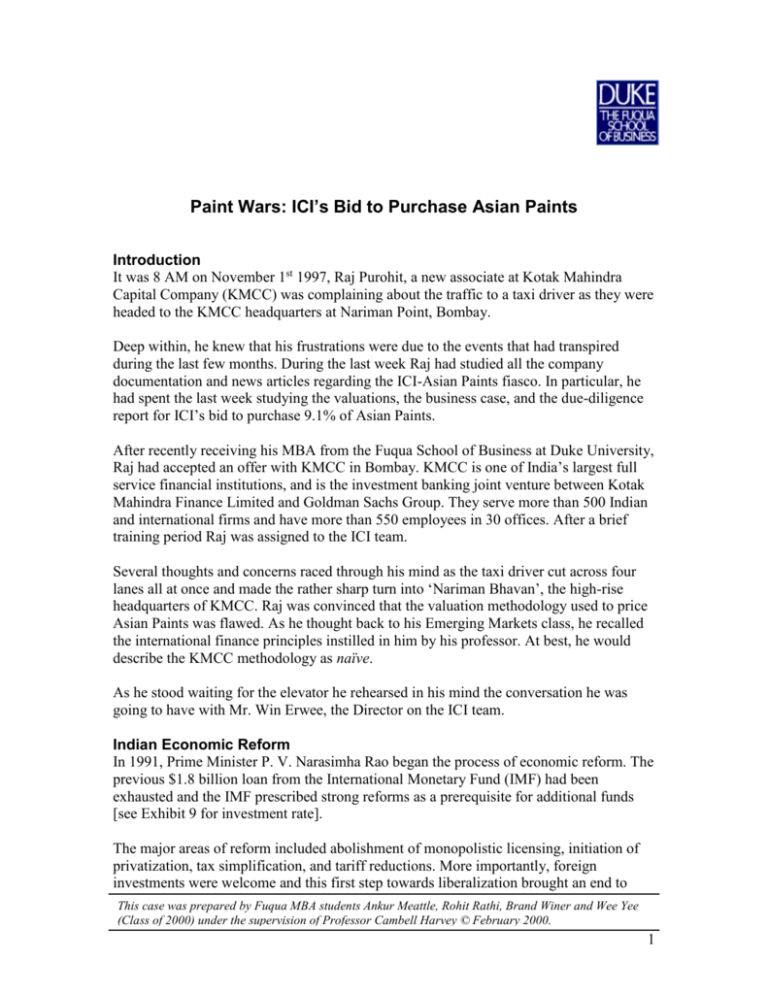
Paint Wars: ICI’s Bid to Purchase Asian Paints Introduction It was 8 AM on November 1st 1997, Raj Purohit, a new associate at Kotak Mahindra Capital Company (KMCC) was complaining about the traffic to a taxi driver as they were headed to the KMCC headquarters at Nariman Point, Bombay. Deep within, he knew that his frustrations were due to the events that had transpired during the last few months. During the last week Raj had studied all the company documentation and news articles regarding the ICI-Asian Paints fiasco. In particular, he had spent the last week studying the valuations, the business case, and the due-diligence report for ICI’s bid to purchase 9.1% of Asian Paints. After recently receiving his MBA from the Fuqua School of Business at Duke University, Raj had accepted an offer with KMCC in Bombay. KMCC is one of India’s largest full service financial institutions, and is the investment banking joint venture between Kotak Mahindra Finance Limited and Goldman Sachs Group. They serve more than 500 Indian and international firms and have more than 550 employees in 30 offices. After a brief training period Raj was assigned to the ICI team. Several thoughts and concerns raced through his mind as the taxi driver cut across four lanes all at once and made the rather sharp turn into ‘Nariman Bhavan’, the high-rise headquarters of KMCC. Raj was convinced that the valuation methodology used to price Asian Paints was flawed. As he thought back to his Emerging Markets class, he recalled the international finance principles instilled in him by his professor. At best, he would describe the KMCC methodology as naïve. As he stood waiting for the elevator he rehearsed in his mind the conversation he was going to have with Mr. Win Erwee, the Director on the ICI team. Indian Economic Reform In 1991, Prime Minister P. V. Narasimha Rao began the process of economic reform. The previous $1.8 billion loan from the International Monetary Fund (IMF) had been exhausted and the IMF prescribed strong reforms as a prerequisite for additional funds [see Exhibit 9 for investment rate]. The major areas of reform included abolishment of monopolistic licensing, initiation of privatization, tax simplification, and tariff reductions. More importantly, foreign investments were welcome and this first step towards liberalization brought an end to This case was prepared by Fuqua MBA students Ankur Meattle, Rohit Rathi, Brand Winer and Wee Yee (Class of 2000) under the supervision of Professor Cambell Harvey © February 2000. 1 more than forty years of socialist and isolationist economic policy. Unfortunately, corporate law, particularly with respect to acquisitions or even minority equity holdings did not develop as quickly, consistently and clearly as an investor might have expected. India lacked relevant and up-to-date corporate governance laws. The combination of economic reform without proper corporate governance laws created a state of flux and ad-hocism. Uncertainty in policies towards foreign capital and investment dates back to the early 1960’s. During this era, in an effort to acquire foreign capital and technology, joint ventures were encouraged. However, strains on the foreign exchange reserves during the 58% devaluation of the rupee in 1966 and the oil shock of 1973 motivated the government to place a 40% limit on foreign equity ownership. During the 1980-oil shock, the government again relaxed its restrictions on foreign investment only to modify these relaxations yet again, later. Another relevant feature of the restrictive investment policy was that the state controlled nearly half the national assets in ‘priority’ sectors such as infrastructure, financial institutions, mining, and telecommunications. The paint industry did not belong in this category and therefore foreign investments in this industry were allowed as long as they met with current guidelines at any given point in time. In 1990, the Indian Government’s “Statement of Industrial Policy” declared that foreign investment was welcome in most industries, and raised the limit of foreign equity participation on new projects from 25% to 40%. In 1992, Prime Minister Rao not only opened up several industries for foreign investment but also allowed majority investments by foreign firms in most industries. Between 1992 and 1997, there were several instances of policy change regarding takeover laws and indirect equity investments. According to the Foreign Investment Promotion Board (FIPB) guidelines announced in January 1997, an overseas corporation could buy into, or enlarge, its holding in an Indian company only if the board of the domestic company allowed it to. [Exhibit 10] The FIPB would decide whether an investment was a holding or a portfolio investment on a case by case basis. The three government entities that would determine the final outcome in the case of any uncertainty related to foreign investment were the FIPB, the Ministry of Industry, and the Reserve Bank of India (i.e. the central bank). The Indian Paint Industry The Indian paint industry did not fall under the protected ‘priority’ sectors as established by the Indian government. Therefore, this industry was open to foreign players. Strategic groups within the industry were primarily based on cost profiles. Large players, or the “organized sector” as it is called by analysts, primarily focussed on conformance and performance quality at a reasonable price. 2 Small local players usually focussed on low cost with very little or no concern for quality. Still they made up 30% of the overall market it terms of sales. The rural customer in India buys primarily on price and small local players could supply paint at 50 to 60% of the price of the organized sector. The cost advantage of the small local players was driven by several factors: cash transactions (income and sales tax evasion), excise tax breaks for small scale producers, price based vendor switching for raw materials (such as pigments), and low overhead from skeleton operations and less costly manufacturing processes (such as no effluent treatment and little quality control). Since the government declared its intention to rationalize taxes (i.e. no advantage to small scale and therefore less evasion) and the environmental movement gathered more momentum (e.g. Meneka Gandhi’s, the former prime minister’s sister-in-law, lobbying efforts were at a peak when 25% of chemical plants were shut down in Gujarat, a state in western India, due to non-compliance with environmental requirements), cost advantages to the small local players would fade. Industry analysts expected the small-scale market share to dip to 10% by the year 2000. The paint industry was divided into two consumer segments: Industrial (such as automotive) and Decorative (such as housing). The organized sector was divided as follows: COMPANY DECORATIVE INDUSTRIAL OVERALL ESTIMATED PAINT REVENUES Rs. 6,980 MM Rs. 3,750 MM Rs. 3,007 MM Rs. 2,254 MM Rs 1,482 MM Asian Paints 38% 14%-16% 32.5% Goodlass Nerolac 7.8% 40% 17.5% Berger Paints *14% *14% 14.0% ICI India Ltd. 8%-9% 12% 10.5% Jenson and Nicholson *6.9% *6.9% 6.9% Growth Rate 8-9% 18% 11% Total (Rs.) 15,033 MM 6,442 MM 21,476 MM * Since these companies strive to match their product sales to the market (i.e. 70% : 30%) they maintain similar market share in each segment. Based on industry reports some of the trends taking shape in the Indian paint industry were as follows: i. Internationally, industrial and decorative paints have 50:50 share of the overall market. In India, the ratio was 30:70 for industrial to decorative paints. This ratio would shift towards the international mix over the next 10 years. ii. Industrial Segment: Automotive paints accounted for over 50 percent of the industrial paint market. Goodlass Nerolac (GN) had an alliance with the US based DuPont since 1996 to garner a large share of the automotive paint market. They supplied 90% of the paint requirements of Maruti, the largest car manufacturer in India (83% market share in the Indian car market). The five million liters per year automotive refinishes market was expected to grow at a rate of 25 percent if the automobile sector grew at a rate of 15 percent per year. Jenson 3 iii. & Nicholson (J&N) entered into a 50:50 partnership with Herberts GmbH of Germany to produce automotive refinishes. Powder coating paint for white goods (like washing machines and refrigerators) accounted for 10 % market share of the industrial paints segment. In powder coatings, GN was a market leader supplying to consumer durable companies like Godrej, Voltas and Whirlpool. GN had an alliance with Valspar Corporation of the US to manufacture powder coatings. Marine paints accounted for 8% of the market. J&N had an alliance with Chogoku Marine Paints of Japan to manufacture bio-friendly marine paints. The market size for marine paints was estimated at Rs 400 MM. Special purpose paints had a 16 % market share. Decorative Segment: While the decorative segment was growing, the players were aware of its decreasing importance. The latest trend in decorative paints was tinting systems. Tinting systems were mix and match assemblies at hardware stores, which had the potential to drastically alter distribution channels with the reduction of inventory. They involved 6-18 basic shades which could me mixed at the store in a small vibro-shaker. An example was Berger’s Color Bank system or ICI’s Colour SolutionTM. Asian Paints India Ltd. In 1942, four partners got together to manufacture paint in a garage in Bombay. The company was named Asian Oil and Paint Company; a name picked at random from a telephone directory. Up against giant international paint companies, Asian Paints hit on the innovative marketing strategy of reaching consumers in the remotest corners of the country with its small, conveniently sized packs. During the 1950’s the company grew from being a family-managed, small-time paint manufacturer to a professionally managed organization competing with the best companies in the world. By 1967, through innovative R&D and ambitious grass-roots marketing, forming strong relationships with thousands of paint dealers in small towns all over India, the company jolted its multinational competitors by emerging as India’s number one paint company. [See Exhibits 1,2,3,6,and 7 for more company information] For the next thirty years they maintained their position as market leader through a four pronged strategy – i. Excellent marketing ii. Intensive distribution iii. Leadership in Information Technology, and iv. Recruitment of young management professionals. In 1996-97 AP’s total sales reached $175 million, almost double that of Goodlass Nerolac Paints, (1996-97 sales $94 million) the number two paint company in the country. Asian Paints had strengthened its technological capabilities through agreements with Nippon Paints of Japan for automotive and powder coatings, Sigma Coatings BV of Netherlands for marine and high-performance coatings, and PPG Industries of USA for the cathodic electrodeposition technology - a much needed enhancement for its automotive business. 4 Prior to the KMCC/ICI sale, the ownership of the company was as follows: Chokseys Danis, Vakils, and Chowksis Total by Promoters Foreign Institutional Investors Non-resident Indians Individual Investors and Public 9.50% 41.06% 50.56% 11.52% 10.19% 27.73% I.C.I India Ltd. ICI India was the subsidiary of the $15BN British multinational company ICI Plc. [Exhibit 8]. Brunner Mond & Co., one of the four Companies that combined to form ICI in UK in 1926, opened a trading office to sell alkalis and dyes in Calcutta. In 1923, Brunner Mond & Co. (India) was incorporated and the company's name was subsequently changed to Imperial Chemical Industries (India) Ltd., in 1929. During its 70 years in India, ICI had created six subsidiary companies in businesses such as research, chlorine, caustic soda, paints, rubber chemicals, explosives, polyester fiber, urea, agrochemicals, seeds, pharmaceuticals, specialty chemicals, polyurethane, nitrocellulose, and surfactants. In 1984, all ICI companies consolidated in one of the largest mergers in Indian corporate history. By 1997, as a part of a restructuring exercise ICI had exited or was planning to exit from several non-core businesses. The 1996 sales break up was as follows: Paints 43%, Explosives 28%, Rubber chemicals 17%, Pharmaceuticals 8%, and Other Products 4%. ICI (India) ranked No. 4 in the paint business, after Asian Paints, Goodlass Nerolac Paints and Berger Paints. Unlike the other paint companies ICI (India) was a diversified unit and paint constituted 43% of its net sales. ICI (India)’s turnover in 1996-97 was $180 million and paint amounted to $77.4 million. ICI identified paints as a thrust area and was aggressively moving to improve their position. They invested $11 million in a new decorative paints plant near Bombay and were constructing a $16.7 million plant for industrial paints near Chandigarh in North India. ICI’s chairman Mr. Charles Miller-Smith said that he would like ICI to become the Indian paint industry leader by 2005. Later he announced that ICI (India) would go on an offensive with a target of achieving ten-fold growth in 10 years. The ‘10X Plan’, as it was called, envisaged a strategy based on acquisitions, take-overs and alliances. ICI’s Bid and Valuation In his report to ICI UK’s CEO Charles Miller-Smith, ICI India’s Managing Director Aditya Narayan listed the advantages and synergies, which formed the basis of the business case for an acquisition of 10% of Asian Paints. 1. Real option value: The most fundamental reason of owning 10% or more of the company was that it would provide real option value. The real option value is the value of the potential positive outcome of an eventual takeover or influence in the board of directors (for a strategic alliance). 5 2. Expandability: Given ICI (India)’s 10X plan, Asian paints with its massive infrastructure would provide an easy avenue for growth. As such it was not easy to expand quickly in India due to bureaucracy, increasing environmental pressures and management issues such as industrial relations, unions, and local nuances with operations. Given the industry growth rate, an acquisition would be an easy and efficient route for growth. 3. Export Barriers: Customs and tariffs make imported paints into India uncompetitive. Access to local manufacturing facilities was perhaps the best way to meet local demand. 4. Excellent Management: Asian Paints was voted in the Economic Times1 Poll as one of the most respected companies to work for in India. It attracted the best management talent in India, on par with foreign multinational companies. 5. Excellent Brand Name: Asian Paints had an excellent brand name amongst consumers. The mascot GattuTM had contributed highly to brand equity. Additionally, GattuTM provided a recognizable symbol to consumers who couldn’t read (e.g. paint contractors). 6. Synergies: In the decorative market, Asian Paints had created leadership, which no company could emulate. ICI’s technical expertise in Industrial Paints would complement this competence and together with Asian’s infrastructure to create a paint powerhouse. Based on these points ICI-UK engaged KMCC to value Asian Paints. The Valuation The valuation was carried out by Raj’s predecessor, Mr. Meattle who was said ‘to have left the firm to pursue other opportunities.’ As Raj examined some of the old valuation files Raj came across the basic structure of the valuation. The valuation comprised of 5 parts: 1. Cost of Capital for ICI 2. Discounted Cash-flow 3. Sensitivity Analysis 4. Option Value 5. Firm Specific Issues While parts 1 through 4 are presented in exhibit [Exhibit 4 and 5], Raj went over the firm specific issues: “The decision of Mr. Atul Choksey to sell his stake in Asian Paints has raised some doubts about the future of the company. The company recorded an unimpressive five percent volume growth in 1996-97. However, in the first quarter of 1997-98, it reported a double digit growth and better results are expected in the second quarter.” “The company needs to grow by 25% per year over the next four years to meet its 2003 target to become one of the top 10 decorative paint manufacturers worldwide by 2003” 1 The most widely read business journal in India. 6 “If the insurance proceeds of Rs. 65 MM (which constitutes 34% of total other income) for fire damage are excluded, the improvement in the after tax earnings works out to just over 10%.” “This insipid performance has not deterred the company from declaring an attractive dividend of 75% of par value. Though the prospects appear bright, they have to be qualified by a few negative factors. Some of the recent developments have significantly changed the company's risk-return profile. One, its weak presence in the high growth industrial segment; Two, though Asian Paints boasts of an extensive distribution network, wide product base, dispersed manufacturing locations and backward integration, competition is quite intense in the decorative paints segment. In this situation, the overall market share of the company could come under severe strain. Three, the commodity nature of Asian Paints product portfolio (pentaerythritol and phthalic anhydride) could also have an adverse impact on its profits and margins. Though the captive consumption level in petaerythritol is quite high, the company sells nearly 70% of the phthalic anhydride in the market, thereby exposing itself to global commodity price swings and volatile demand-supply dynamics.” “Though Asian Paints may manage to remain a leading player in the industry, the pace of growth in profits and margins would be slower compared to its competitors. Viewed in this light, the stock, now trading at Rs. 350, appears overpriced. The current discounting of 23 times, based on an EPS of Rs. 15.20, is far higher than that commanded by most competing stocks (between 8-12 times). Investors may wait till a major correction takes place in the stock.” Real Option Value: In addition to a regular DCF valuation, Mr. Meattle had described the real option value as follows. “The investment could be useful to ICI which plans to expand its paints business tenfold over the next ten years. The promoters hold a major 40.6% stake, Unit Trust of India (UTI), the oldest and one of the largest mutual funds in India, holds a 9.82% stake and the public hold 30% stake. If ICI can obtain the stake of another promoter or UTI they would have significant influence in the affairs of Asian Paints and improve the bargaining position of ICI. ICI, after gaining a majority stake in Asian Paints, may merge which would result in a consolidated turnover of Rs. 12000 MM from paints, far more than the Rs. 3750 MM turnover of its nearest competitor, Goodlass Nerolac.” Current Situation On August 1, 1997 ICI and KMCC entered into an agreement that ICI would provide KMCC with a non-interest-bearing loan. KMCC would purchase shares from Atul Choksey the late chairman’s son at Rs. 347.5 per share. ICI UK would then buy these shares “subject to approval”. In exchange for brokering this deal, KMCC would receive Rs. 20 MM as investment banking fees. [See Exhibit 11 for a detailed timeline.] 7 On August 17th, 1997 a Principal to Principal, Spot Basis Sale was made for 9.08% stake by the late chairman’s son Atul Choksey at Rs 347.5 per share. Immediately, thereafter the other three promoters entered into an agreement, which prevented them from selling their stakes to any outside party. On August 21st, 1997 Asian Paints’ new chairman Ashwin Chowksi made the following statement: "The board is of the unanimous view that this represents an attempt by a multinational rival to acquire a foothold in the company." Mr. Chowksi added that guidelines from the Indian Foreign Investment Promotion Board state that before government approval can be granted to foreign investors, the board of a company has to support the investment. "Our board of directors is of the opinion that such investment is in nobody's interest and will not be welcome. This move does not add any value to our operations in India, and it does not enhance shareholder value." Vice-chairman of Asian Paints, Ashwin Dani defended the decision not to transfer shares to KMCC in a strongly worded statement, “The entire consideration for the purchase of these shares having come from ICI Plc., the transaction is to be considered benami (anonymous) or a sham transaction prohibited by law.” During the last week of August and September, ICI released statements assuring Asian Paints that it was not planning a takeover. Said Mr. Narayan: “ICI is trying to convince FIPB that the acquisition is only for investment purposes and to prevent its competitors from buying the stake. We are trying to convince the Asian Paints board that it is a one time foreign investment and that the purchase would not mean any additional rights other than dividend income. We would seek an alliance with Asian Paints, not an outright takeover.” Raj’s manager Mr. Win Erwee had hired Raj primarily because of his summer experience at Credit Suisse First Boston, in New York, where he worked on valuation in the mergers and acquisition group. Mr. Erwee had told Raj, “This is probably the greatest challenge you will ever face after business school - a deal gone awry, an unclear legal system, and a stock market that has severely punished our decision.” Raj recalled from yesterday, that Asian was trading at a low of Rs. 281 in the Bombay stock exchange. Furthermore, Mr. Erwee had reminded Raj of the importance of ICI as a client of the firm. “ICI plans to invest Rs. 11,600 MM in the next 10 years in India. If we make this deal work, we are in for a long advantageous relationship with a $16 BN multinational. This is an opportunity to establish yourself as the financial doctor who saved the ICI deal.” 8 Possible Courses of Action As Raj went up the elevator, he pulled out his palm pilot from his brief case and opened the memo “Options”. It read: 1. 2. 3. 4. 5. 6. Sell back to 3 remaining promoters Sell stock back to Asian Paints Negotiate with ICI to bear/share all losses and sell the stock in the market Appeal to FIPB emphasizing ICI’s long term financial commitment to India Appeal to Ministry of Industry Declare investment as “alliance only” and not “direct acquisition”, divest to a local ICI subsidiary – government may not allow 7. Demand nominee of Company board - 25% vote required to pass this and other special resolutions 8. Have ICI UK transfer stock to ICI India – Government may not allow 9. International law? With these in mind, Raj and Mr. Erwee had until the afternoon before the ‘big meeting’ with Mr. Charles Miller-Smith and Mr. Aditya Narayan at ICI headquarters. 9

